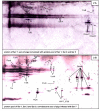Proteomic and immunoproteomic characterization of a DIVA subunit vaccine against Actinobacillus pleuropneumoniae
- PMID: 21507263
- PMCID: PMC3107771
- DOI: 10.1186/1477-5956-9-23
Proteomic and immunoproteomic characterization of a DIVA subunit vaccine against Actinobacillus pleuropneumoniae
Abstract
Background: Protection of pigs by vaccination against Actinobacillus pleuropneumoniae, the causative agent of porcine pleuropneumonia, is hampered by the presence of 15 different serotypes. A DIVA subunit vaccine comprised of detergent-released proteins from A. pleuropneumoniae serotypes 1, 2 and 5 has been developed and shown to protect pigs from clinical symptoms upon homologous and heterologous challenge. This vaccine has not been characterized in-depth so far. Thus we performed i) mass spectrometry in order to identify the exact protein content of the vaccine and ii) cross-serotype 2-D immunoblotting in order to discover cross-reactive antigens. By these approaches we expected to gain results enabling us to argue about the reasons for the efficacy of the analyzed vaccine.
Results: We identified 75 different proteins in the vaccine. Using the PSORTb algorithm these proteins were classified according to their cellular localization. Highly enriched proteins are outer membrane-associated lipoproteins like OmlA and TbpB, integral outer membrane proteins like FrpB, TbpA, OmpA1, OmpA2, HgbA and OmpP2, and secreted Apx toxins. The subunit vaccine also contained large amounts of the ApxIVA toxin so far thought to be expressed only during infection. Applying two-dimensional difference gel electrophoresis (2-D DIGE) we showed different isoforms and variations in expression levels of several proteins among the strains used for vaccine production. For detection of cross-reactive antigens we used detergent released proteins of serotype 7. Sera of pigs vaccinated with the detergent-released proteins of serotypes 1, 2, and 5 detected seven different proteins of serotype 7, and convalescent sera of pigs surviving experimental infection with serotype 7 reacted with 13 different proteins of the detergent-released proteins of A. pleuropneumoniae serotypes 1, 2, and 5.
Conclusions: A detergent extraction-based subunit vaccine of A. pleuropneumoniae was characterized by mass spectrometry. It contained a large variety of immunogenic and virulence associated proteins, among them the ApxIVA toxin. The identification of differences in expression as well as isoform variation between the serotypes implied the importance of combining proteins of different serotypes for vaccine generation. This finding was supported by immunoblotting showing the induction of cross-reactive antibodies against several surface associated proteins in immunized animals.
Figures


References
-
- Torremorell M, Pijoan C, Janni K, Walker R, Joo HS. Airborne transmission of Actinobacillus pleuropneumoniae and porcine reproductive and respiratory syndrome virus in nursery pigs. Am J Vet Res. 1997;58:828–832. - PubMed
-
- Fenwick B, Henry S. Porcine pleuropneumonia. J Am Vet Med Assoc. 1994;204:1334–1340. - PubMed
LinkOut - more resources
Full Text Sources
Molecular Biology Databases
Research Materials
Miscellaneous

